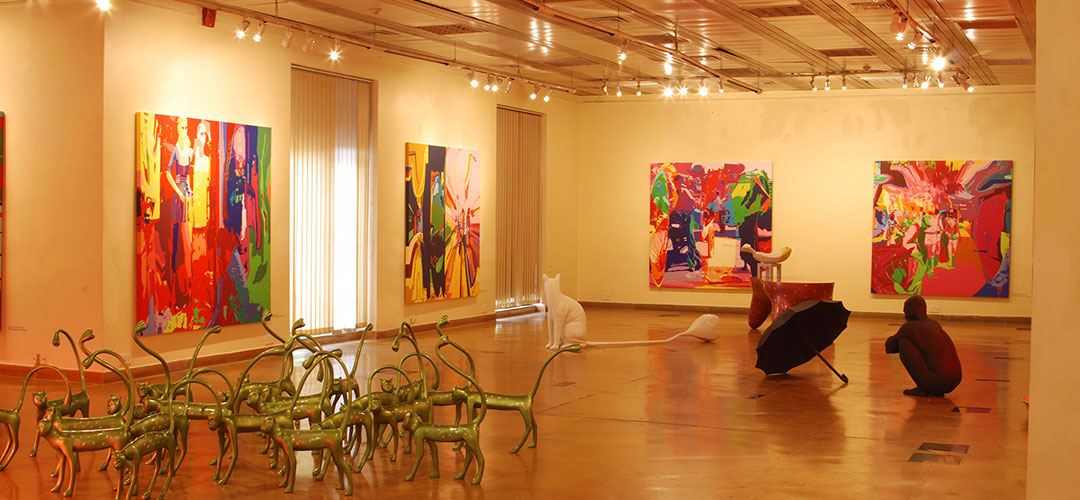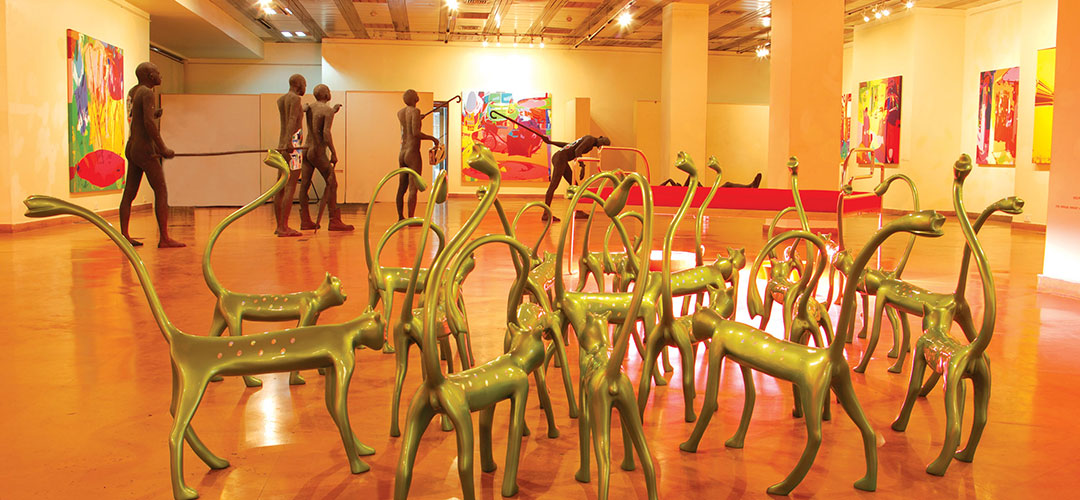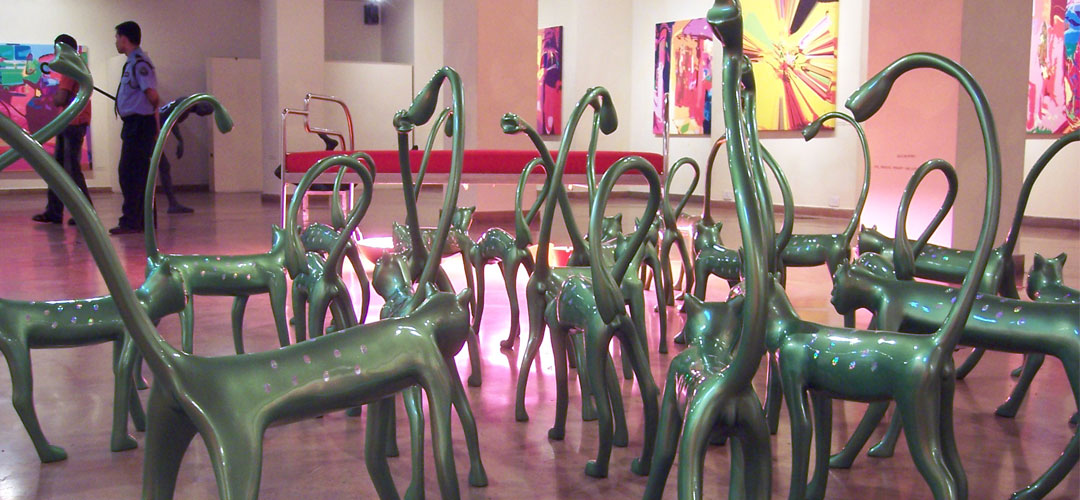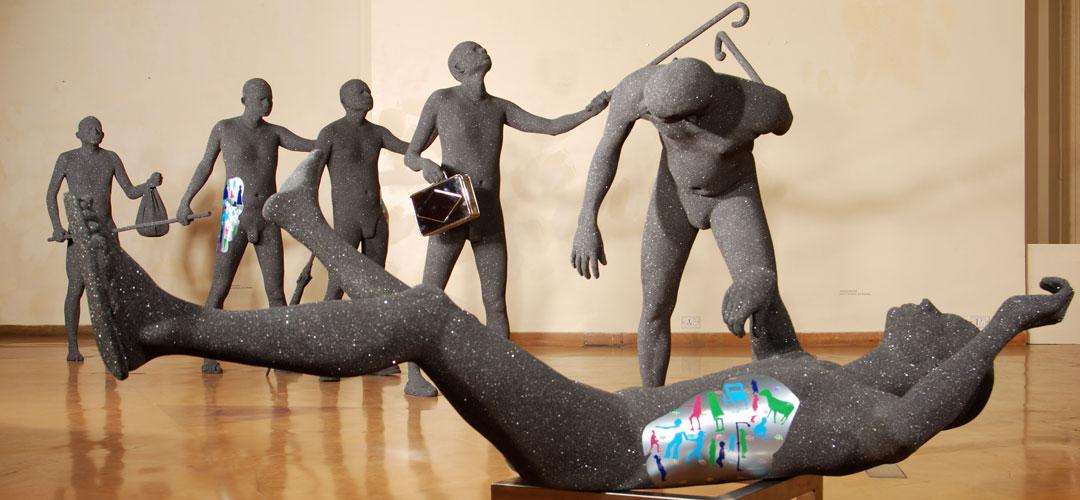Description
George Martin P.J calls his assemblage of works ‘ Lost Article’. The name is more a metaphor for nostalgia, left behind memories that human beings cherish on. It often becomes a routine for aging, solitary people to converse with the ‘self’, and sometimes for young romantics to pause for a moment, moving away from the racing track of survival and look back at the childhood years, when things were different, funny or mysterious…
Martin appears to be one amongst them, who possesses an insight when speaking about life, by reflecting back to his reservoir of memories, small events or moments that turn into treasure, while understanding/interpreting the present.
In his top floor studio at Muhammedpur, with pieces of his about to finish sculptures lying all around and the entire space being flooded with strong light from the summer sun of Delhi, Martin was talking about his reluctance to intimidate his audience with jargoned explanations about his art works. He insisted that it is an open-ended effort; his recent art works are ambitioned at, one is totally free to look at his art works from different or may be original perspectives and create meanings accordingly.
This is a fabulous way of interactive art making, where the artist-viewer relationship is not stereotyped, as long as perceptions of both the parties are allowed with an outlet. Those art works, which are critiqued, to be too closed, as forms, may fail to provide such a space that Martin’s works does.
His studio looks deceptive enough to confuse an intruder for a surreal space, reminding of a Lewis Carol scripted situation, where a battalion of cats headed by a leader white cat, whose tail has metamorphosed into a flower. This is fascinating, when the artist like an alchemist lives in his secluded, magic-real world, and enjoys the expression of astonishment on his viewers face, as each image or form of art starts decoding by it self… that is where the interaction begins.
A well read, eager to explore person like him, doesn’t pester much about what or how much power/spell his art would cast on the viewer-interpreter, rather it is the idea which becomes a primary cause to make art. Once the fundamental ideas are conveyed, the creator then sits back to enjoy multiple reactions and interpretations from the audience-consumer. Martin’s world which is highly receptive, gives a hint that it is largely shaped up by his keen interest in films, literature and memories, these very organically concoct and morph into paintings and sculptures.
These terms appear and actually have become too formal, academic or even consumer oriented in the present socio-cultural and economic context, to limit Martin’s art works with these terms would be injustice. They would sound better if being described as ‘solidified ideas’. Encountering the established beliefs and ideas that terms like ‘painting’ or ‘sculpture’ carry, his works pronounce nonconformist ways of denying boundaries and limits that art canons pose. This is to further confirm that expression and representation of thoughts are basic responsibilities that a cerebral person, say an artist should bear. Martin takes a maverick stance by almost establishing such a belief with his
body of art works. Here his works are clarified enough to state that a medium is just a ‘medium’ which helps an artist to facilitate his expression of ideas and not the other way round. At this point it should be mentioned that he works with materials, which could be of any other use, apart from encoding artistic expressions. Steel, wood, auto paints, vinyl, fiberglass, neon light, cloth, silicon, aluminum, rice etc.
Making art with non-conventional objects does not raise brows any longer, especially after beer and soup cans are iconified, therefore the world of visual arts is getting exhausted and getting jabbed faster with each passing day, so far mythification or de- mythification of art objects are concerned. In such a situation the materials Martin works with and the reason behind the usage does not need meticulous decoding, because specialized interests and education on visual arts, very promptly, enables one to recognize the capacity of representational eloquence these materials pose. But a viewer’s intuition says that there should be more than gimmick to an artwork. Such a probability is totally valid when one stands near Martin’s works.
This I say because, within my short span of interaction with Martin, I found him to be a wonderful ‘storyteller’. While we talked over, Martin mentioned at a point, that him being a sculptor, by the silent rules of an existing hegemony, does not mean, that he has to remain confined within the dictated and directed space, instead by the right of a creative person, he can oscillate between multiple modes and languages of expression. This is what he has done with his current body of works, standing by his beliefs.
What his art works are, and I believe all meaningful art works should be, interspaces or pockets which constantly intervene into the locus of meaning generative areas, that ebbs and tides across the creative ground injecting and accepting concepts and beliefs.
What I left unsaid earlier in this paragraph is that, the artist is an amazing storyteller, both in a literal sense and metaphorically, much like the way Walter Benjamin talks about. Where meaning generation of an artwork goes hand in hand with the artist’s perception and the viewer’s reception. Here the artist-viewer relationship resembles that of the ‘storyteller’ and the ‘listener’. Benjamin comments ‘ what allows the story told by the storyteller to be reproduced is not the context of what is told…. for it would not survive the moment of it’s initial twilling, here story and memory are homologous with oblivion and news.’ In this context the image (story) produced by the artist is the element or mediator of transmission, which always presupposes a community of receiver, and turns the listener/viewer into a storyteller/composer in turn.
Discussing his works we talked about Iranian filmmaker Abbas Kiarostami, and Latin American writer Gabriel Garcia Marquez, both gifted with the mesmerizing skills to capture the attention of the audience, by sheer narrating stories. Stories about class, beliefs, location and stories about the ‘magic’ and the ‘real’. The same narrated through mediums, which are marked as high art forms is no less a skill. Especially when the viewer is offered limitless freedom to create parallel levels of narrative with her/his imagination. At this point the idea of the artist is materialized, when an interactive process begins with the artist/story teller leaving the story unfinished for his audience.
What if rose is called poppy?
Of course rose will remain the same, with its intrinsic qualities of fragrance and beauty…. the way before its name was changed. Similarly while reading art works such as these, it becomes inevitable that the elementary characteristics of the author/artist remains unchanged irrespective of what he is designated, painter, sculptor, novelist, animator, filmmaker…The art works are signifiers to particular concepts or signs, about which most of us hold pre-conceived notions. When this equation fails to work, the regular audience gets displeased. But art works are not meant to be predictable, encaged within the pseudo-safety periphery of understandability.
Coming back to discuss about art works of Martin, it can be mentioned without hesitance, that he juggles the simple with the complex, juxtaposing small but significant information and reminiscences locked in the attic with the contemporary fluxed state of organic existence, which is changing, dismantling and reforming again like a phoenix. His playful way of whirl pulling his long accumulated reserve of experience, cultural references and a wacky sense of humor, reproducing them through paintings and sculptures is startling. It must be mentioned here that the last one, that is humor, is the most important component of his imagery formulation.
The titles selected for his works such as ‘Blind lead Blinds’, or ‘Concave Breath’ , ‘ ‘Uncertainty of Poet’ or may be ‘Codes of Conducted Smiles’, all suggest, the wit that the these works encash. Looking into them carefully reveals a fact, sharper the edges of ones wit, the crispier the language of representation appears. Martins assimilated bunch of sculptural projects and paintings happily live up to this anticipation.
One of his work named ‘Blind lead Blinds’, is totally provocating for an interpreter, because this is one, which transgresses the unseen line of grand narrative of a widely discussed painting by Peiter Bruegel, and translates the spirit into three dimensional forms, creating an illusion every moment. Each of the blind is given a face that resembles the artist’s self-portrait. The irony is better sensitized at the moment of visual encounter, rather that literal explanation.
Adaptation of a famous painting from the European high renaissance period, which is already laden with multitude of meaning, is an act of relevance to Martin. He says, ‘Bruegel is still so much contextual…so contemporary’.
May be this is a way an art language transcends its time and space, and travels to another era carrying equally potential possibilities. Bruegel in his time was an avant-garde, painting landscape scenes independent of any religious cause, or talking about the peasants and their livelihoods in his paintings, while being nurtured by a bourgeois nexus.
Remembering these facts from history, quite naturally leads the viewer to connect with the sculpture at different levels. One at the citation of cultural reference, another at the level of noticing the medium handling, where each figure is casted in fiberglass then coated with silicon, giving a black illuminated look and painted sporadically with automobile paints, lastly thinking about the present context where an urbanite from 21st century is relocating a statement, which is several hundred years old, and belongs to a different part of the sphere.
Bruegel became relevant to different creative people at different points, like Andrey Tarkovsky in his films, Mirror, or Andrei Rublev or Solaris incorporated scenes from his paintings. Even the way Gert Hofmann’s novel Der Blindensturz (The Parable of the Blind) depicts the figures in ‘Blind leading the Blind’. George Martin’s work, reminds of the chain of cultural past one leading to the other.
Another interesting work of his named ‘ Drizzling memory’ offers a flashback to childhood memories, when the darkness beneath the bed, raised unresolved curiosity, paired with an uncanny sensation. As we talked Martin mentioned once, that cats creep under the darkness of the beds. That is one powerful childhood memory…
It is an experience of traveling to and fro in time, leafing memories, while talking to him, looking at his art works, and wondering why some things get lost from the remembrance reservoir and some stay on…?Sharing , sometimes recalling images, imaginary scenes, or questions that used to rattle in the mind as a child …but got lost in the way of ‘growing up’.
Avijna ‘07
New Delhi.
Details
Show Date
May 7-12, 2007
Venue
Visual Art Gallery,
India Habitat Centre, New Delhi, India
Content
Four sculptural installations and Sixteen Paintings
Sculptural installation
Blind leads blinds
Concave breath
Drizzing memory
Uncertainity of poet
Paintings
1. A trace of lace
Acrylic on canvas, 78″x78″, 2007
2. Brick by brick
Acrylic on canvas, 78″x78″, 2007
3. Codes of conducted smiles
Acrylic on canvas, 78″x78″, 2007
4. Guard & vanities
Acrylic on canvas, 78″x78″, 2007
5. Lessons from mimic route
Acrylic on canvas, 78″x78″, 2007
6. Loop & holes
Acrylic on canvas, 78″x78″, 2007
7. Mystic montage
Acrylic on canvas, 78″x78″, 2007
8. Peep into the past
Acrylic on canvas, 78″x78″, 2007
9. Uninterpreted entropy
Acrylic on canvas, 78″x78″, 2007
10. Wrecked broadway
Acrylic on canvas, 78″x78″, 2007
11. A toast of tuskers
Acrylic on canvas, 58″x58″, 2007
12. Fragile reflections
Acrylic on canvas, 58″x58″, 2007
13. Manmade cavities
Acrylic on canvas, 58″x58″, 2007
14. Refractive idols
Acrylic on canvas, 58″x58″, 2007
15. Secret of pale ochre dust
Acrylic on canvas, 58″x58″, 2007
16. Uncutted monologue
Acrylic on canvas, 58″x58″, 2007






